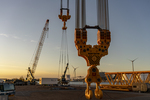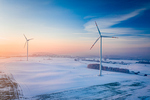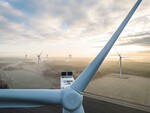06/18/2010
Mexico - Obstacles for Wind Energy Development
Mexico offers significant wind power potential with conditions that are considered among the best in Latin America, especially in the area of “La Ventosa”, Oaxaca (7,000 MW) with average capacity factors above 40%. In addition, other sites in several states also offer good wind farm potential, in particular “La Rumorosa” in the state of Baja California and sites in the states of Tamaulipas, Yucatán, Veracruz, Zacatecas, Hidalgo and Sinaloa.
The Ministry of Energy (SENER) has estimated that a total of 40,000 MW of wind energy potential could be developed in Mexico. Despite this significant potential, wind power development in Mexico has been slow, mainly due to the lack of adequate financial incentives, issues with the existing regulatory framework and a lack of policies to encourage use of wind energy.
However, in 2009, new laws and regulations were introduced to boost renewable energy development, and more than 560 MW of wind turbines projects are currently under construction. Mexico has around 50 GW of total installed electricity generation capacity, including 11,457 MW from independent power producers (IPP) and about 7,900 MW of self-generation and cogeneration capacity.
During the last years, the generation mix in Mexico changed significantly, moving away from fuel-oil generation plants to natural gas-based generation. Traditionally, large hydroelectric and geothermal energy have been Mexico’s most widely used renewable sources. Other renewable energy sources, such as wind power, solar photovoltaic, small hydro, biomass, and biofuels have experienced only slow growth to date.
In 2009, Mexico’s installed wind capacity more than doubled with 117.4 MW of new capacity added to the existing 84.5 MW operating at the end of 2008. The total installed wind power capacity now amounts to 202.28 MW. This increase was the result of two private wind farm self-supply projects brought online in 2009, “Parques Ecológicos de México” (79.9 MW) and the first phase of the “Eurus” project (37.5 MW).
They were added to the two existing CFE projects La Venta I (1.6 MW) and La Venta II (83.3 MW).Of course, the global economic and financial crisis has, as in other countries, had a negative impact on financing for wind energy in Mexico. Projects suffered from financial institutions’ shrinking risk appetite, as well as from their preference for more developed markets.
To date, Mexico still lacks a fair and clear regulatory framework to promote renewable energy. The state-owned enterprise Federal Commission for Electricity (CFE), is responsible for two thirds of Mexico’s energy generation and nearly all of its transmission, and has favoured the development of conventional energy sources in the past, as well as some large hydro and geothermal projects.
In addition, wind power developers are in direct competition with the CFE, while depending on it for basic interconnection and transmission services. In 1992, the amendment of the “Electric Energy Public Service Law”3) allowed the private sector to participate in power generation, either through self-generation for particular entities or individuals, through generation from Independent Power Producers (IPP), or for export to other countries.Under the self-generation scheme, power consumers can produce electricity for their own use, which will get delivered to the CFE interconnection point and then transported to the consumer.
To date, a total of 598 self-supply power generation permits have been granted by the Energy Regulatory Commission (CRE), accounting for a total of 6,105 MW, with wind energy accounting for a third of the permits issued to date.Under the Independent Power Producer (IPP) scheme, private producers with plants over 30 MW must sell their power to the CFE through long-term power purchase agreements (PPA).
Since 1992, more than more than 20% of Mexico’s power generation is supplied by IPPs using conventional thermal power generation. There are now two IPP wind farm projects under construction; “La Venta III” (101 MW) and “Oaxaca I” (101 MW), both of which are expected to start operation in 2010. In October 2008, the Mexican Congress approved the Energy Reform bill, which also included a new Renewable Energy Law) (LAERFTE), aiming at reducing Mexico’s fossil fuel dependence by promoting renewable energy technologies.
The new law recognises that renewable energy needs both significant support and financial incentives to achieve its potential. The bill put SENER in charge of drafting a renewable energy programme, and it called for the development of a national strategy for the sustainable use of energy. Various bodies were created to design a renewable energy strategy and related public policies, which also involve the private sector.
Along with the LAERFTE, a “Special Program for the Use of Renewable Energy” was issued, setting the objective of increasing the share of renewable energy in the total national installed generating capacity from 3.3% (1,900 MW) to reach 7.6% (4,500 MW) by 2012; wind power is expected to account for more than half of this capacity.
Finally, a Renewable Energy Fund was created to promote the use of renewable sources and energy efficiency, including providing financing guarantees and direct support. Three billion pesos (220 million US$) have been allocated for this on an annual basis from 2009 to 2011.
The Mexican wind energy industry is facing numerous problems, including insufficient transmission infrastructure and unclear rules for power transmission that make it difficult for private companies to develop and expand the renewable energy market. In addition, there are no specific support mechanisms or other incentives, and the rules for the Renewable Energy Fund remain undefined.
Other obstacles include a weak judicial system, problems with long-term land leasing and conflicting objectives of the national utility and RE project developers.
While there is strong interest in wind energy development in Mexico from the side of the private sector, it is critical that federal and state governments address those obstacles in order to secure investments. Based on currently known or announced projects, around 3,600 MW of wind farms could be operational by 2014.
For more information please contact Trevor Sievert at ts@windfair.net
The Ministry of Energy (SENER) has estimated that a total of 40,000 MW of wind energy potential could be developed in Mexico. Despite this significant potential, wind power development in Mexico has been slow, mainly due to the lack of adequate financial incentives, issues with the existing regulatory framework and a lack of policies to encourage use of wind energy.
However, in 2009, new laws and regulations were introduced to boost renewable energy development, and more than 560 MW of wind turbines projects are currently under construction. Mexico has around 50 GW of total installed electricity generation capacity, including 11,457 MW from independent power producers (IPP) and about 7,900 MW of self-generation and cogeneration capacity.
During the last years, the generation mix in Mexico changed significantly, moving away from fuel-oil generation plants to natural gas-based generation. Traditionally, large hydroelectric and geothermal energy have been Mexico’s most widely used renewable sources. Other renewable energy sources, such as wind power, solar photovoltaic, small hydro, biomass, and biofuels have experienced only slow growth to date.
In 2009, Mexico’s installed wind capacity more than doubled with 117.4 MW of new capacity added to the existing 84.5 MW operating at the end of 2008. The total installed wind power capacity now amounts to 202.28 MW. This increase was the result of two private wind farm self-supply projects brought online in 2009, “Parques Ecológicos de México” (79.9 MW) and the first phase of the “Eurus” project (37.5 MW).
They were added to the two existing CFE projects La Venta I (1.6 MW) and La Venta II (83.3 MW).Of course, the global economic and financial crisis has, as in other countries, had a negative impact on financing for wind energy in Mexico. Projects suffered from financial institutions’ shrinking risk appetite, as well as from their preference for more developed markets.
To date, Mexico still lacks a fair and clear regulatory framework to promote renewable energy. The state-owned enterprise Federal Commission for Electricity (CFE), is responsible for two thirds of Mexico’s energy generation and nearly all of its transmission, and has favoured the development of conventional energy sources in the past, as well as some large hydro and geothermal projects.
In addition, wind power developers are in direct competition with the CFE, while depending on it for basic interconnection and transmission services. In 1992, the amendment of the “Electric Energy Public Service Law”3) allowed the private sector to participate in power generation, either through self-generation for particular entities or individuals, through generation from Independent Power Producers (IPP), or for export to other countries.Under the self-generation scheme, power consumers can produce electricity for their own use, which will get delivered to the CFE interconnection point and then transported to the consumer.
To date, a total of 598 self-supply power generation permits have been granted by the Energy Regulatory Commission (CRE), accounting for a total of 6,105 MW, with wind energy accounting for a third of the permits issued to date.Under the Independent Power Producer (IPP) scheme, private producers with plants over 30 MW must sell their power to the CFE through long-term power purchase agreements (PPA).
Since 1992, more than more than 20% of Mexico’s power generation is supplied by IPPs using conventional thermal power generation. There are now two IPP wind farm projects under construction; “La Venta III” (101 MW) and “Oaxaca I” (101 MW), both of which are expected to start operation in 2010. In October 2008, the Mexican Congress approved the Energy Reform bill, which also included a new Renewable Energy Law) (LAERFTE), aiming at reducing Mexico’s fossil fuel dependence by promoting renewable energy technologies.
The new law recognises that renewable energy needs both significant support and financial incentives to achieve its potential. The bill put SENER in charge of drafting a renewable energy programme, and it called for the development of a national strategy for the sustainable use of energy. Various bodies were created to design a renewable energy strategy and related public policies, which also involve the private sector.
Along with the LAERFTE, a “Special Program for the Use of Renewable Energy” was issued, setting the objective of increasing the share of renewable energy in the total national installed generating capacity from 3.3% (1,900 MW) to reach 7.6% (4,500 MW) by 2012; wind power is expected to account for more than half of this capacity.
Finally, a Renewable Energy Fund was created to promote the use of renewable sources and energy efficiency, including providing financing guarantees and direct support. Three billion pesos (220 million US$) have been allocated for this on an annual basis from 2009 to 2011.
The Mexican wind energy industry is facing numerous problems, including insufficient transmission infrastructure and unclear rules for power transmission that make it difficult for private companies to develop and expand the renewable energy market. In addition, there are no specific support mechanisms or other incentives, and the rules for the Renewable Energy Fund remain undefined.
Other obstacles include a weak judicial system, problems with long-term land leasing and conflicting objectives of the national utility and RE project developers.
While there is strong interest in wind energy development in Mexico from the side of the private sector, it is critical that federal and state governments address those obstacles in order to secure investments. Based on currently known or announced projects, around 3,600 MW of wind farms could be operational by 2014.
For more information please contact Trevor Sievert at ts@windfair.net
- Source:
- Online Editorial, www.windfair.net
- Author:
- Posted by Trevor Sievert, Online Editorial Journalist
- Email:
- ts@windfair.net
- Link:
- www.windfair.net/...
- Keywords:
- Wind energy, wind power, wind turbine, wind mill, offshore, onshore, wind farm, renewable energy


























